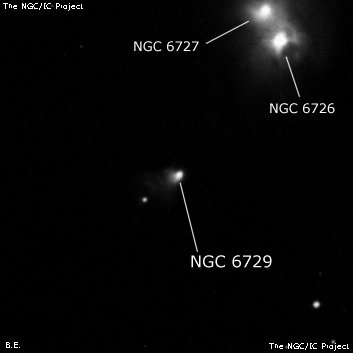
Julius Schmidt discovered NGC 6729 on 15 Jun 1861 with the 6.2" refractor at the Athens Observatory. He noted a faint, but clearly visible stellar nebula involved with a star identified as "nx", though his reported RA in 1865 was 4 minutes too large (typo). Albert Marth rediscovered this bright reflection nebula on 1864.50 (about 2 Jul) and noted "*13m with a vF, nebulous tail." His position is accurate.
The illuminating star is variable R CrA (T Tauri type). Schmidt discovered the variability of R CrA in 1866 and the variability of T CrB in 1876. He also suspected the nebula was variable. Observing with the 7" refractor at the Cape Observatory, Robert Innes confirmed the probability of the nebula's variability and reported R and T CrA "seem to be placed at the two ends of the major axis of a faint elliptical nebula, which is brightest to R." With the 18" refractor on 15 Oct 1900, he noted "the nebula does not extend to T CrA and that it is fan-shaped, agreeing very closely with Marth's description."
Delisle Stewart first photographed the region on 4 Aug 1899 at Harvard's Arequipa station, followed in 1910 at the Transvaal (Union) Observatory at Johannesburg with the Franklin-Adams camerand by Knox-Shaw at the Helwan Observatory starting in 1911 with the 30-inch Reynolds reflector.
In describing the opaque dark cloud that spreads SE of NGC 6729, Innes wrote in 1910: "Both Mr. Worssell and the writer when examining this region have suspected the presence of an obscuring medium as the cause of the unusual lack of stars. In fact, the 9-inch refractor with a field of 25' can be pointed to one part of the region, so that not a solitary star of any magnitude is to be seen. There is probably no other such region in the whole sky. Mr Worssell considers that when the edge of the blank region is made to cross the field of the low-power Zeiss eyepiece with an apparent diameter of about 30', a distinct difference in tint between the blank and starry parts of the sky is perceptible."
200/250mm - 8" (7/31/81): faint, elongated nebulosity attached to R Coronae Australis (9.7-13.5) with a comet-like appearance. Located 5' SE of brighter NGC 6726/6427 in a remarkable field.
300/350mm - 13.1" (8/15/82): at the edge of the field with NGC 6723 is this cometary nebula. Elongated with a star attached at the tip.
400/500mm - 17.5" (7/29/92): fairly faint, elongated 4:1 WNW-ESE, 2.0'x0.5'. Variable star T Coronae Australis (mag 11.7-13.5) is attached at the SE end and the nebulosity extends to WNW. Variable star R Coronae Australis (mag 9.7-13.5), which illuminates the nebula, is at the NW end. The unusual cometary appearance is similar to Hubble's Variable Nebula. The brighter reflection nebulae NGC 6726/NGC 6727 lies 5' NW. Located in a remarkable field of nebulosity and the bright globular cluster NGC 6723.
Notes by Steve Gottlieb